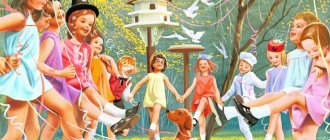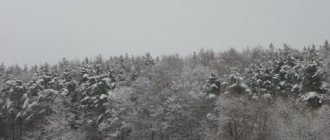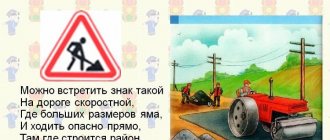Reading stories about plants is an important element of the aesthetic education of children. Works of classical literature are best suited for this purpose.
The most popular authors who worked on natural history topics are N. Sladkov, K. Ushinsky, M. Prishvin, S. Aksakov. Their works not only help children develop speech and creative thinking. They reveal even in a simple blade of grass and an ordinary dandelion a whole world and a special character.
This selection offers the most stories by these authors that are suitable for reading to children. Dandelions, birches, water lilies, reeds - all the plants described by the classics live their own lives and help people.
Spring
Ushinsky K.D.
The days begin to noticeably increase from the middle of December; and by March 9th it will take half a day. That’s why the beginning of spring is counted from March 9th. In spring, the sun not only stays in the sky longer, but also warms up noticeably more every day.
The snow begins to melt little by little, and water runs in streams from the ground into rivers and lakes. Soon the ice on the rivers will give way to the influence of the sun's rays. Large polynyas appear along the banks of rivers. Another week will pass - and all the ice will rise with the rising water, turn black, begin to break, and loose ice floes will rush down the river. At this time, there is so much water in the river that it cannot fit into the banks: it protrudes and spills over the surrounding meadows. A river flood is called a water field. Another river is so small that in the summer they could ford it; it spills into the water field for five, six miles or more. Our Mother Volga, into which thousands of rivers and rivulets flow, spreads out like a sea in the spring. People rush to take advantage of the short-lived wealth of water, and large barges loaded with goods sail in the spring where chickens almost wander in the summer.
At first, thawed patches appear in the fields, but soon the ground, wet and saturated with water, appears everywhere from under the snow. Another week will pass, then another, and the snow will only remain somewhere in a deep ravine where the sun does not shine. The sky is getting bluer and the air is getting warmer.
Not all the snow has yet melted when new, bright green grass begins to appear here and there, near the old yellowed grass. In the fields where peasants have sowed rye or wheat since the fall, winter crops rise and turn green, like green velvet.
Along with the grass, the first flowers appear. A blue snowdrop emerges from under last year's leaves in the forests. Here and there a yellow dandelion appears, the same one that will eventually put on its fluffy white cap, round like a ball and so light that you just have to blow on it and it will all fly apart.
The trees also awaken from winter sleep and, warmed by the sun, are filled with juices. If you cut through the bark of a birch or maple tree at this time, sweet and fragrant sap will drip from under it.
The leaf buds have been prepared by the tree since autumn. All winter they remained in one position and were barely noticeable; now they begin to quickly fill up, grow, shed their brown husks and unfold into green leaves.
Fluffy flowers, or lambs, appear on the willow. You probably noticed them on the willow branches on Palm Sunday? Then barely noticeable, sticky and fragrant birch leaves appear. Another ten days passed - and the curly, bright green birch tree, with its white, neat trunk, stood decorated as if for a holiday: cheerful, bright, fragrant. Behind the birch, linden, alder, and oak are in a hurry to bloom. The palmate leaves of the maple do not take long to appear. Shrubs and trees in front of each other are in a hurry to dress up for the spring festival. At first, the greenery on the trees seems liquid, because the leaves are still small, and in some places there is still black earth visible through the bright green grass. But the leaves and grass grow quickly, and by May everything will turn green: the groves will again become impenetrable, and the fields will be full of thousands of flowers. In winter, monotony reigns: all the same snow. But in the spring, every day something new appears: then the blue eye of a forget-me-not will peek through; then a fragrant cup of lily of the valley will unfold, but yesterday it was not there; then the white strawberry flowers will sparkle in the greenery, from which juicy, red berries will emerge by the end of spring. Cherries, apple trees, and pears are covered with white and white-pink flowers. Everything celebrates spring, everything blooms and smells fragrant.
Spring does not begin at the same time everywhere. The further south you go, the earlier spring gets. In Crimea, flowers are picked already in February, and in Arkhangelsk you can freeze your nose in April.
Birds, along with spring, appear in abundance. The rooks are the first to arrive and remind us with their screams that spring has begun. They almost always appear around March 9th. But then the lark, rising high in the air, sang its sonorous song. Fast, sharp-winged swallows arrive a little later. Starlings, blackbirds, waders, wild pigeons, and cuckoos appear one after another and inhabit fields, forests and groves that were recently silent.
High in the air, flocks of cranes, wild ducks, geese and swans stretch from south to north. Soon the nightingale will begin her sonorous song. Some of these birds, wild geese, cranes, swans, fly further; others stay with us all summer; those that remain begin to build nests: they rush around, scream, work, collect dry twigs, straw, moss, grass.
Busy ants, colorful butterflies, clumsy beetles, and then unbearable mosquitoes and midges, thousands of the most diverse flying and crawling insects come into the light of God. A hardworking bee, having slept through a long winter in a warm hive, wakes up, leaves its wax cell and flies to collect sweet honey from flowers.
There is noticeably less change in the animal kingdom. Wild animals are rarely seen at all. But you can’t help but see how happy livestock are about spring. After standing in barns for a long winter, horses, cows, and sheep happily run out into the field, and the shepherd doesn’t have to call them out of the house for long with his long pipe.
People are happy about the first snow, but they are also happy about the first flowers. Every season brings its own pleasures and its own worries. Double glazing is taken out in houses; fresh air and bright light rush into the room. Sounds from the street, which could not be heard behind the double glass for six months, are heard loudly. And for the peasants there is so much work to be done! But they are not afraid of work. Over the winter, bread, oats, hay and even straw - everything will be converted: one for food for people, the other for feed for livestock. We need to get to work so that we have something to eat for next fall and winter.
The peasant straightens the cart, adjusts the harrow and plow, and when the earth has warmed up a little and dried out, he goes to the field. He plows, harrows the field and sows spring crops on it, which must be sown and harvested in the same year: oats, buckwheat, barley, millet. In the gardens they dig ridges, plant potatoes, onions, peas, beans, cabbage; they sow hemp, beets, carrots, turnips. In the capitals, wealthy people move to their dachas, where gardeners arrange flower beds, plant and sow flowers. The poor man also rejoices in the spring: thank God - it has become warmer! God's sun shines freely for everyone, equally for everyone; less firewood is needed and the thin dress is more bearable.
Language development
In the old days there was a saying among the Russian people - “tea”. This is not a drink, but a replacement for the concepts “most likely”, “apparently” or “perhaps”. Even from here a fairy tale about a plant can be composed. This, of course, is Ivan-tea. How could a flower that wonderfully decorates all our July fields have such a strange name?
Once upon a time there lived a handsome guy in a village - Ivan. And his shirts were all very beautiful: pink and crimson, scarlet and red. He used to put on his crimson shirt and go out to the edge of the forest for a walk. It can be seen far away among the greenery. That’s why one or another villager said, putting his palm to his forehead: “What is this? Oh, it’s Ivan, tea, walking there again!” Many, many years have passed, both Ivan’s children and grandchildren have become old, and people keep repeating: “What is that there? Ah, Ivan, tea.” Because beautiful crimson flowers have grown everywhere, which people call Ivan-tea. And botanists call this plant fireweed.
Sultry afternoon
Aksakov S.T.
I have always loved and love the heat of our short summer... The sultry afternoon is blazing. Perfect silence. The wide pond, green as a spring meadow, covered with grasses, does not sway, as if sleeping in its sloping banks; the reeds stand motionless.
The mainland and the grass-free channels shine like mirrors; the rest of the water is overgrown with various aquatic plants. Either bright green or dark-colored leaves spread across the water, but their roots go deep into the muddy bottom; white and yellow water lilies, the color of burdocks, simply called pitchers, and red flowers of dark grass protruding above long, cut-out leaves diversify the green carpet covering the surface of the pond.
What a luxury of warmth! What bliss and benefit to the body! How pleasant is the proximity of water and the opportunity to refresh your face and head with it!
The fish is also hot: it seems to be sleepy standing under the shade of the grass. Seeing tasty food, only for a moment it lazily swims out to clean places, pierced by the sun's rays, grabs the prey and hurries under its green canopies.
Intrigue
However, a fairy tale about plants will not be interesting if there is no action in it. For example: “Once upon a time, an old woman found a tall, beautiful bush, with unprecedented flowers. The petals are orange, with curved tips. And it’s as if everything in freckles is speckled. It grew up alone." Girls will probably choose a fairy tale about a wild plant with beautiful flowers. They don’t yet know that their favorite “saranka” or “tiger lily” is called lanceolate lily, and it came to dachas and lawns just from the wild.
Such a fairy tale about a wild plant that has been domesticated will awaken curiosity and arm you with knowledge. Surely the lily in the children's story was enchanted, and the old woman will have to fight for the bulb of this plant to take root in her garden. You can imagine how other plants helped the wild lily to enter their community, how harmful insects, which were sent, for example, by the evil forest kikimora, prevented this, and how good insects helped defeat the evil ones. And you get a fairy tale about a wild and cultivated plant at the same time. It is necessary to clarify how the lily has changed, becoming beautiful year after year thanks to new conditions: the flowers have become larger and brighter, and the bush is taller and denser.
Golden Meadow
MM. Prishvin
My brother and I always had fun with them when dandelions ripened. It used to be that we would go somewhere on our business - he was in front, I was at the heel.
Seryozha! - I’ll call him in a businesslike manner. He will look back, and I will blow a dandelion right in his face. For this, he begins to watch for me and, like a gape, he also makes a fuss. And so we picked these uninteresting flowers just for fun. But once I managed to make a discovery.
We lived in a village, in front of our window there was a meadow, all golden with many blooming dandelions. It was very beautiful. Everyone said: Very beautiful! The meadow is golden.
One day I got up early to fish and noticed that the meadow was not golden, but green. When I returned home around noon, the meadow was again all golden. I began to observe. By evening the meadow turned green again. Then I went and found a dandelion, and it turned out that he squeezed his petals, as if your fingers on the side of your palm were yellow and, clenching into a fist, we would close the yellow one. In the morning, when the sun rose, I saw the dandelions opening their palms, and this made the meadow turn golden again.
Since then, dandelion has become one of the most interesting flowers for us, because dandelions went to bed with us children and got up with us.
Start
Of course, the child should already have a certain base of rules characteristic of fairy tales. This is always accompanied by reading. Before writing, you need obligatory observations on walks, stories about the characteristics of various plants: is it beneficial or harmful, is it a wild weed or a cultivated plant, ornamental, medicinal or edible. A fairy tale about plants usually begins in the same way as other fairy tales: “Once upon a time...” or “In a distant country...” - and this choice can be entrusted to the child.
Next, you need to jointly decide what kind of story it will be - scary, with adventures, kind or just educational. This decision will determine the choice of the main character. Although a fairy tale about plants will be composed, the presence of a main character is mandatory. It can be a tree, a bush, a flower, or a berry, but the presence of a person is quite appropriate. For example: “Once upon a time there lived an old woman on the edge of the forest in her rickety hut. She spent days wandering through the forest and collecting various herbs, berries and flowers. These were not simple plants, but healing ones. People from the village often came to the old woman for help: she would cure colds and remove bruises for the children.”
How a shirt grew in a field
Ushinsky K.D.
I
Tanya saw her father scattering handfuls of small shiny grains across the field, and asked:
- What are you doing, father?
- But I’m sowing flax, daughter; a shirt will grow for you and Vasyutka.
Tanya thought: she had never seen shirts growing in a field.
About two weeks later the strip was covered with green silky grass and Tanya thought: “It would be nice if I had a shirt like that.”
Once or twice Tanya’s mother and sisters came to weed the strip and each time they said to the girl:
- You will have a nice shirt!
A few more weeks passed: the grass on the strip rose, and blue flowers appeared on it. “Brother Vasya has such eyes,” Tanya thought, “but I’ve never seen such shirts on anyone.”
When the flowers fell, green heads appeared in their place. When the heads turned brown and dried out, Tanya’s mother and sisters pulled out all the flax by the roots, tied sheaves and put them in the field to dry.
II
When the flax dried out, they began to cut off its heads, and then they sank the headless bunches in the river and piled another stone on top so that they would not float up.
Tanya watched sadly as her shirt was drowned; and the sisters then told her again:
- You have a nice shirt, Tanya.
About two weeks later, they took the flax out of the river, dried it and began to beat it, first with a board on the threshing floor, then with a whip in the yard, so that the poor flax sent fire flying in all directions. Having frayed, they began to comb the flax with an iron comb until it became soft and silky.
“You’ll have a nice shirt,” the sisters said to Tanya again. But Tanya thought: “Where is the shirt? It looks like Vasya’s hairs, not a shirt.”
Ill
The long winter evenings have arrived. Tanya's sisters put flax on their combs and began to spin threads from it. “These are threads,” Tanya thinks, “but where is the shirt?”
Winter, spring and summer have passed, autumn has come. The father installed crosses in the hut, pulled the warp over them and began to weave. The shuttle ran quickly between the threads, and then Tanya herself saw that canvas was coming out of the threads.
When the canvas was ready, they began to freeze it in the cold, spread it on the snow, and in the spring they spread it on the grass, in the sun, and sprinkled it with water. The canvas turned from gray to white, like boiling water.
Winter has come again. The mother cut shirts from canvas; The sisters began to sew shirts and for Christmas they put new shirts, white as snow, on Tanya and Vasya.
Little tales about plants
This can be done right on walks, because there are always plants underfoot that a child must learn from an early age. It will be both informative and interesting. For example, a fairy tale about medicinal plants may well begin with plantain, the first remedy for bruises and bumps, abrasions and scratches. One boy, who recognized this plant and then wrote a fairy tale about plantain, even tried to cure a broken wheel on a toy car with the help of such a green leaf.
And you can continue it about everyone’s favorite chamomile - also a useful plant, but a fairy tale about it usually turns out to be sad. It’s not in vain that people use chamomile petals to tell fortunes about their betrothed – whether he loves or doesn’t love. And the flower is left with one lonely yellow center, which is immediately thrown away. And there was such a cute plant that delighted the eye. A short fairy tale about plants should definitely teach an attitude towards nature.
Poisonous but useful
Everywhere in vacant lots and near fences you can see lush bushes with bright yellow flowers. In Greek it is chelidonia, and in Russian it is celandine. The plant is very healthy, but you can’t eat it, because you can get poisoned. You can come up with a very interesting tale about this grass, be it short or long. For example, there once lived a young lady. Fair, tall, good-looking, but with a terrible character.
She once offended a hungry old woman and did not allow her to pick a sweet apple in her garden. And she didn’t break off a piece of her pie at her request. The old woman was not evil, but she was fair. “You cannot deceive people with such a beautiful and pure face,” she said, “if the soul is so black and callous!”
Option 3. A story about the beauty of plants using the example of a forest
Nature is always beautiful, but every season of the year the forest is beautiful in different ways.
In summer, the bright greenery of the tree crowns pleases the eye. White birch trees rustle their leaves in clearings with lush grass, willows with branches reaching to the ground sway in the wind. Mighty oak trees stretch high to the blue sky. Wild tulips glow among the grass, berries hang on the bushes like a scattering of candies.
In autumn, the forest becomes colorful, as if an artist painted the foliage in different shades. The leaves of maples are turning purple, aspens and poplars are putting on a yellow outfit. The ground in the forest is covered with a carpet of fallen leaves. The bare branches of the bushes look like dark lace.
Winter - and the forest becomes elegant and white. Spruce and pine trees stand under snow cover, and the green needles sparkle with white snowflakes. Pine cones hang like New Year's toys, and snowdrifts under the trees look like white cotton wool. Bright clusters of rowan berries glow like red beads on the branches.
In spring, the forest wakes up, tree branches become covered with buds, light and delicate greenery appears before our eyes. Cheerful streams flow along the slopes, and thawed patches appear on the paths. The clearings are covered with young growth, and wonderful snowdrops - small white flowers - appear like in a fairy tale.
Bell
Bells are also called the same in all languages, only the words sound differently, but the meaning remains the same. There is a legend that the church bell appeared in Italy in 1500 not by accident. Its prototype is a flower that the bishop of Campania (an Italian province) liked so much that he even seemed to hear the ringing. Returning from a walk, he ordered a copper bell.
This story may well become the basis for a fairy tale about plants. Like, for example, a bell calls everyone to a council to help children lost in the forest. You can also compose a fairy tale about a coachman freezing in the steppe, who saw blue flowers in a dream and realized that he needed to tie ringing bells to his horse harness, then you wouldn’t get lost or go astray even in a snowstorm. Fairy tales about plants for children are very important. They need to be told so that the child understands how the story is built.
Option 7. A story about the beauty of plants in the Altai region
Scatterings of Altai wildflowers, luxurious green meadows, and the ribbon forest of the Altai Territory are gifts, treasures of our nature. From one contact with beauty we get pleasure and a good mood.
A luxurious flowering field will never be forgotten
Have you ever been to the Altai Territory? Have you stood in an endless colorful field of flowers? Altai flowers, which emit a soft, fresh light, nod their heads, as if they are saying “look at us, we are wearing our best clothes today.” The smell of chamomile buds, buttercups, tulips, and cornflowers lulls you to sleep. There is a barely perceptible sound of real life around - the buzzing of bees, the chirping of birds. Overhead there is a blue sky with unique patterns of clouds. The picture is unforgettable. This is heaven on earth! This is a wonderful Altai region!
Belt bur - edge brand
Ribbon pine forests are unique natural areas created by nature. They are visible from space as dark green synchronous stripes crossing the plain. Unusual and incredibly beautiful! 87% of the forest consists of pine, there is a beautiful mountain ash, red viburnum, medicinal rose hips, and hawthorn. And how many berries are there in these forests with different tastes, colors, and smells! Who hasn't admired birch shards! Each birch tree has a unique, memorable beauty!
Each blade of grass is dedicated to miracles, silence and goodness
The Altai steppe is different everywhere, bright and full of life. Wheat, rye, and corn fields delight with their colors and attract with their significance, harmony and innocence. Sunflowers tirelessly turn their yellow hats after the sun! Isn't this a miracle of nature! No artist can convey the beauty, the color of this world. Only Mother Nature can do this!
All we have to do is enjoy the wildflowers, grasses, pines, Russian birches, the vast fields of the region, its sky, and never forget this beauty.
Option 10. A story about the beauty of plants in the Perm region
All the beauty of the nature of the Perm region can hardly be experienced on excursions in museums. No, they are good and sometimes even interesting, but they cannot compare with trips to the forest. Each such trip is a discovery. Only there on the spot do you understand how rich the nature of my region is, how beautiful it is. We go hiking all year round, even in winter. And these thousands of plant species always meet us in a different outfit and in a different composition. In autumn they are dressed in dazzling bright colors, and in winter in sparkling snow-white fur coats. In the summer, when life is seething and gaining strength, all plants, from wildflowers to pine giants, dizzy with their aromas and excite with an abundance of color. Absolutely all shades of colors are buried in an ocean of spreading greenery. There are unique plants that are listed in the Red Book of the Perm Territory. They are reliably protected in the territory of nature reserves (Basegi, Vishersky, etc.). I advise everyone to start with practice, so that they can personally touch and admire them, and only then truly love their Motherland.
All answers to workbooks on the world around us, detailed analysis of complex tasks here
Hello! My name is Maria, I am the author of the Pushkin website. I hope that my site helps you, in turn I ask for your help. My son was diagnosed with autism. He needs daily correctional activities, if you can help, I will be grateful to you. Every 10 rubles you give is another chance for my child to live a full life. Collection page here
Forget-me-not
Parents base most children's stories for school lessons on ancient legends, epics, and even songs. For example, the fact that the name of the forget-me-not flower from all languages of the Earth, including Japanese and Arabic, is translated the same way (“don’t forget me!”) will definitely arouse children’s interest. Here you can retell the ancient Greek myth about the appearance of this plant, and even then your own story may well appear.
The touching name of forget-me-not already predisposes you to write. For example, a man leaves for war and asks his family not to forget him. And he picks a little blue flower, which will lie among the pages of his favorite book until his return. And if the person does not return, the forget-me-not will turn into tears, because every clearing, every woodland, every meadow will remind of this person.
Option 9. A story about the beauty of plants in the Urals
Diversity of plants of the Urals.
Plants fascinate us with their beauty, splendor, bright colors, wonderful aromas. How pleasant it is to stroll through a spring and summer meadow and admire these beauties. The beautiful Urals are especially rich in diversity of plant species and forms! Here you can see various flowering herbs, perennials and annuals, most of which are used to make medicine. Dozens of rare species grow in the Urals that cannot be found anywhere else.
Herbs of the Urals.
Knotweed spreads across meadows and pastures in a beautiful green carpet with small white or pink flowers. It is harvested as medicine and as livestock feed. In damp places, forests and swamps you can find beautiful valerian. Its pinkish flowers are collected in umbrellas and always captivate passers-by with their aroma. Burnet is highly valued in the Urals. It has flowers that look like bright burgundy balls or heads, which have been used by local residents for healing since ancient times. The bright blooming colors in the Urals will also delight you with lumbago, St. John's wort, tansy, wild garlic and many other beautiful plants. People travel vast distances, even come from other countries, to see the beautiful flowering meadows of the Urals, to pick rose hips, strawberries, and a wonderful bouquet of wild daisies, dandelion and thyme in the forest.
Yablonka
A fairy tale about plants should be life-affirming. For example, about a young apple tree that bloomed for the first time. Oh, what beautiful flowers she has! In this snow-white and pinkish veil, she is the spitting image of a bride! The apple tree is happy, even a little proud, although all the plants around are blooming and smelling, since spring is such a time of year. But the apple tree is now the most beautiful of all. And suddenly! What kind of misfortune is this? The breeze blew and carried away the petal. Then another one, and another!
And so the apple tree litters the last of its curls and cries. What peduncles have become inconspicuous... Gray, large, ugly nodules... But time went on and on. The apple tree, of course, did not forget the lost outfit, but life took its toll, and every day something on the branches became so heavy that it even became difficult to hold. It turns out that these are fruits! They grew large, glossy, and bright by autumn. And how joyfully people looked at this tree, decorated with fruits! And even when the apples were collected, and the branches felt light again, even when the last leaves of the apple tree had fallen, she was no longer upset, because she understood: spring would come soon, she would put on a snow-white veil again, then the apples would ripen red... Everything would be fine -sho!
Field and forest plants
Around every city, even the largest city, there are always fields and forests, it just takes a long time to get to them. That’s why people love city parks so much, where almost all plants gather, for which only a forest or field can be considered a home. When parents take their baby for a walk, his attention needs to be paid to literally all manifestations of life: what the weather is like, where the breeze is blowing from, where the sun warms better, why shadow is formed, where grasshoppers live, when butterflies appear, and so on. Only under such conditions will the child’s imagination develop, and by the second grade of school he will be able to independently compose fairy tales about plants and animals.
For example, any clearing in the park can be presented to a child as magical. Smart and talking plants grow on any of them. They even know how to play ball using a drop of dew, and the wind blows it from bluebell to chamomile, from yarrow to St. John's wort. Living in the clearing is both interesting and fun for them. The paths are always framed by dandelions and plantains, which suffer more than others from careless running around, but they cannot be completely trampled. There would be many interesting tales about their vitality.









